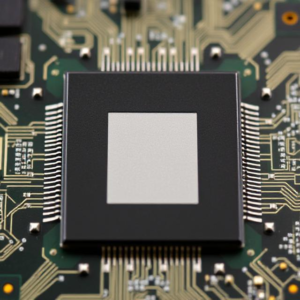What is a Microprocessor ?
Microprocessors are used for tasks that require powerful processing capabilities, like running operating systems and complex applications. They need external components to work and are used in general-purpose devices like computers and smartphones.
A microprocessor is the central processing unit (CPU) of a computer or other device. It is a single-chip processor that carries out most of the tasks involved in computing, like processing data and executing instructions. It is primarily used in general-purpose computing devices like computers, laptops, and smartphones.

Features of Microprocessors:
CPU on a Single Chip: The microprocessor contains the core computational unit (the CPU), which performs all the calculations and controls the operation of the computer.
External Components: A microprocessor usually requires external components like memory(RAM, ROM), input/output devices, and peripherals (keyboard, display, etc.) to function.
Complex: It is designed to perform a wide range of tasks and can run complex software applications (like operating systems and programs).
Microprocessor Key Components:
- CPU (Central Processing Unit):
- The CPU is the “brain” of the microprocessor. It carries out all the computational tasks like arithmetic calculations, logic operations, data manipulation, etc.
- ALU (Arithmetic Logic Unit):
- The ALU performs mathematical and logical operations (like addition, subtraction, AND, OR, etc.).
- Control Unit (CU):
- The control unit fetches instructions from memory and decodes them to control the operations of the processor.
- Registers:
- Small, fast storage units within the CPU used to hold data and instructions temporarily during processing.
Characteristics:
- External Memory and I/O: Microprocessors don’t have built-in memory or I/O interfaces (like sensors, motors, or keyboards). These need to be added externally. The microprocessor typically interacts with external memory (RAM, ROM) and I/O devices (keyboard, display, etc.) via buses and controllers.
- Processing Power: Microprocessors are generally designed for high processing power and flexibility. They can handle complex operations, multitasking, and work with various external peripherals.
- General Purpose: A microprocessor is a general-purpose processor, meaning it can be used for a wide variety of tasks in computers, servers, and other devices where complex computations are required.
Applications:
- Computers: Desktops, laptops, and workstations.
- Smartphones: High-end devices where powerful computing is needed.
- Servers: For heavy data processing, computations, and multitasking.
- Gaming Consoles: Where processing power is essential for gaming applications.
Example of Microprocessors:
Personal Computers: The heart of desktops and laptops (e.g., Intel Core processors).
Smartphones: Microprocessors in smartphones run the operating system and apps.
Laptops/Tablets: These devices use powerful microprocessors to manage tasks.
What is a Microcontroller ?
Microcontrollers, on the other hand, are specialized devices that combine a processor, memory, and I/O functions on a single chip. They are designed for dedicated tasks in embedded systems, like controlling a washing machine, managing a car’s engine, or handling sensors in a robot.
A microcontroller, on the other hand, is a small computer on a single chip designed to handle specific tasks or control processes in embedded systems. It’s much more specialized and self-contained compared to a microprocessor.

Features of Microcontrollers:
All-in-One Chip: A microcontroller combines a CPU, memory (RAM, ROM), and input/output peripherals (like timers, communication interfaces) all on a single chip.
Designed for Specific Tasks: Microcontrollers are designed for dedicated applications, meaning they are optimized to control devices or process information for specific functions. For example, controlling a washing machine’s operations or managing the functions of a microwave.
Smaller, Cheaper, and Low Power: Microcontrollers are typically smaller in size, more affordable, and consume less power than microprocessors.
Microcontroller Key Components:
- CPU:
- Like the microprocessor, the CPU is the core that performs calculations and logic operations.
- Memory:
- RAM (Random Access Memory) for temporary data storage.
- ROM (Read-Only Memory), or Flash memory, for storing the program that controls the microcontroller’s actions.
- I/O Pins:
- Microcontrollers have built-in input/output pins that can be used to connect to various devices like sensors, switches, motors, or displays. These pins can be used for reading inputs or sending outputs.
- Timers and Counters:
- Microcontrollers often have built-in timers for tracking time or performing repetitive tasks at specific intervals.
- Communication Interfaces:
- Common communication protocols (like UART, SPI, I2C) are also built into many microcontrollers, allowing them to communicate with other devices.
- ADC/DAC (Analog-to-Digital and Digital-to-Analog Converters):
- Some microcontrollers include converters to handle analog signals, which is helpful for interacting with analog sensors like temperature sensors, light sensors, etc.
Characteristics:
- Integrated Components: Microcontrollers have all the necessary components (CPU, RAM, ROM, I/O) on a single chip, making them self-sufficient.
- Specialized Tasks: Microcontrollers are designed for specific applications, and they typically perform a single task, such as controlling a device or interacting with a sensor.
- Low Power Consumption: Microcontrollers are optimized for low power consumption, which is important for battery-powered devices.
- Cost-Effective: Due to their integration of multiple functions, microcontrollers are usually cheaper compared to systems that use a microprocessor and separate components.
- Real-Time Operations: Many microcontrollers are designed to handle real-time operations (e.g., controlling motors, turning on lights at specific intervals, etc.).
Applications:
- Embedded Systems: Used in devices like washing machines, microwaves, and toasters where they control specific tasks (turning motors on/off, managing timing functions, etc.).
- Arduino and Raspberry Pi: Popular in DIY electronics and hobby projects.
- Automobiles: Microcontrollers manage many in-car systems like airbags, anti-lock brakes, engine control, etc.
- Home Automation: Controls smart home devices like light systems, thermostats, and security cameras.
- Medical Devices: Used in devices like blood glucose monitors, pacemakers, and other medical equipment for monitoring and controlling functions.
Example of Microcontrollers:
Home Appliances: Microcontrollers control tasks like timing in microwaves or washing machines.
Automobiles: They manage engine control, airbags, and other car systems.
Robotics: Microcontrollers are used to control the movements and operations of robots.
Embedded Systems: Used in devices like digital cameras, printers, thermostats, and more.
Differences Between Microprocessors and Microcontrollers :
| Feature | Microprocessor | Microcontroller |
| Purpose | General-purpose computing (like running operating systems) | Specialized for controlling specific tasks in embedded systems |
| Components | Only the CPU (requires external memory and peripherals) | Contains CPU, memory, and I/O on the same chip |
| Complexity | More complex, designed for running software programs | Simpler, designed to handle specific tasks |
| Power Consumption | Higher power consumption due to its complexity | Lower power consumption, designed for efficiency |
| Cost | Generally more expensive due to its complexity | Typically cheaper and cost-effective for specific tasks |
| Size | Larger in size, especially when external components are added | Smaller, compact, all-in-one design |
| Examples | Used in computers, laptops, smartphones, and gaming consoles | Used in appliances, automobiles, medical devices, robots |
Summary:
- Microprocessors are powerful units used in general computing devices like computers and smartphones. They need external components for memory, I/O, and peripherals, and they are used in systems requiring high processing power.
- Microcontrollers, on the other hand, are used for specific tasks in embedded systems. They integrate all necessary components (CPU, memory, I/O) into a single chip and are typically used in applications like home appliances, robotics, and other devices where low power and simple control are key.
Tags: Address Bus, ALU, arithmetic logic unit, ARM Processors, Buses, cache memory, central processing unit, Chipset, clock speed, Complex Applications, complex systems, Complex vs Simple Design, Computational Tasks, Computing Device vs Embedded Device, Computing Hardware, Computing Power, Control Bus, Control Unit, Controllers, CPU, CU, Data Bus, data centers, data manipulation, data processing, Desktops, digital processing, Execution Unit, External Components, External I/O, External Memory, External vs Integrated Components, gaming consoles, General Purpose vs Dedicated Task, General-Purpose Computing, General-Purpose Devices, High Cost vs Cost Effective, High performance, High Power vs Low Power, High-End Devices, input/output devices, Instruction Decode, instruction execution, instruction fetch, Instruction Set Architecture, Intel Processors, laptops, Larger Size vs Compact Size, Microcontroller, Microprocessor, Microprocessor vs Microcontroller, Multitasking, Operating System, Performance Efficiency, Peripheral Interface, Peripherals, Personal Computers, Processing Power, Program Counter, RAM, Real-time processing, registers, ROM, Servers, Single-chip Processor, smartphones, Software Applications, System Architecture, tablets


